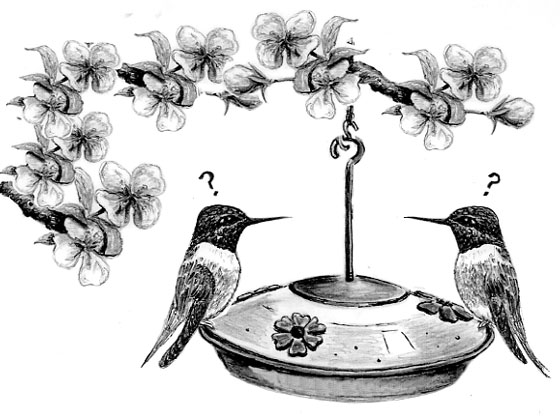
Dear Bird Folks,
Last weekend I put up my hummingbird feeder (yes, I purchased it at your store) and two hummingbirds arrived yesterday afternoon. One was a ruby-throat and one had an entirely black throat. After checking in my field guide, it looks like it’s a Black-chinned Hummingbird. Is that possible on the Cape?
-Susie, Harwich, MA
Maybe, Susie,
Ordinarily I would have doubted anybody who reported seeing a Black-chinned Hummingbird around here. This hummingbird is normally found in the western half of the country. But clearly you are an intelligent person. Your shopping habits alone indicate just how brilliant you are. While I’m typically not so complimentary, in this economy I’m more than happy to suck up to anyone who buys something from me. Last week I even smiled at a lady who was wearing a sweatshirt with a picture of a cat on it. You know things are bad when I do something like that.
Actually, I wasn’t kidding or trying to suck up when I said “maybe” about you seeing a Black-chinned Hummingbird in your yard. In the world of birds it seems that anything is possible (except for keeping squirrels off of feeders). However, seeing a black-chinned in Harwich isn’t likely, especially in the spring. Fall is when hummingbirds most often lose their way, or explore new territories, depending on whose side of the story you want to believe. (Hummingbirds, especially the males, hate to admit when they are lost.) To my knowledge there’s been only two confirmed records of this Western hummingbird ever visiting Massachusetts; however, one of those times was just three years ago in the nearby town of Brewster. So, like I said, maybe.
Of all the birds that regularly visit our yards hummingbirds are the most challenging to identify. Just about anyone can tell a House Finch from a goldfinch or a Red-breasted Nuthatch from a White-breasted, but hummingbirds can be tricky. Right now some readers are thinking: “Come on. The ruby-throated Hummingbird has a ruby throat and the Black-chinned Hummingbird has a black chin. What could be easier?” To which I reply: “Hey, you are right. I never thought of it that. Why am I making this so difficult? I’d better think about this for a second.” All right, a second is up. I’ve got it.
The striking, brilliant patch of red on the male Ruby-throated Hummingbird’s throat is only striking and brilliant when the sun is hitting it just right. Without proper lighting the bird’s throat doesn’t look red at all; it looks black. That’s right, black. In good light the throat of a male Black-chinned hummingbird appears to be two-toned. The lower half is shiny purple, while the top half is sold black, which gives it the signature black chin. But in poor light the bird’s entire throat looks black, just like the ruby-throat. If you check out the illustrations of these two birds in your Sibley Field Guide To Birds, you will see profiles of both birds that look nearly identical. “What’s that you say? You don’t have the Sibley guide?” Gee, I wonder where you can get one (hint, hint).
The Black-chinned Hummingbird is often described as the ruby-throat of the West. Not only do the two birds look similar, but they also have similar habits. Both birds love the suburbs, love the flowers we plant and love to come to our feeders. Like most hummers black-chins build their nest out of plant fiber and spider web silk. The spider silk not only holds the nest firmly in place, but it allows the nest to stretch as the baby birds grow. Man, hummingbirds are smart. Having a home that automatically expands as the little birds grow is a great idea. The best we have come up with are stretch pants and I don’t think we should be proud of that.
One of the indications that your hummingbird may be a black-chin is the way it hovers. This bird loves to pump and spread its tail while it hovers at feeders, while the ruby-throat typically keeps its tail still. If you are one of those hip, techie types, there is a great video you should check out on YouTube. (You know YouTube…it’s the website that all the kids, and adults with no life, sit and watch for hours on end.) There is one clip of a Black-chinned Hummingbird hovering at a feeder. The feeding bird is flicking its tail up and down so quickly it looks as if it has an extra wing. So, if the bird that’s coming to your feeder has three wings, it might possibly be a black-chin. Either that or you have something terribly wrong with your vision.
If, after reading all this, Susie, you still think your mystery bird is a Black-chinned Hummingbird, I suggest you break out your camera and take some pics. Rare birds need to be well documented or none of the eggheads will believe you. Be prepared to be let down, though. A few weeks ago I took a picture of what I thought was a Golden Eagle. Golden Eagles are rare around here and I was all excited. But after showing the picture to an eagle expert I found out that I was wrong. The bird that I thought was a Golden Eagle turned out to be a Golden Retriever. I need to get a new camera.